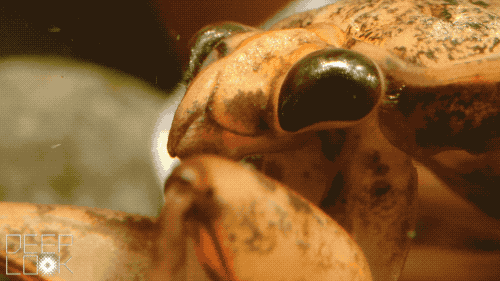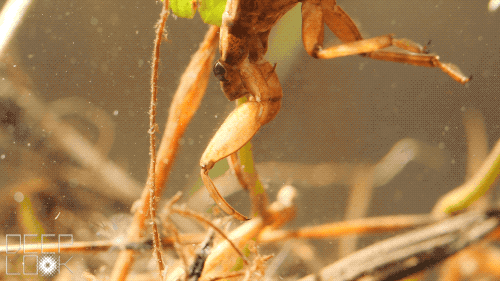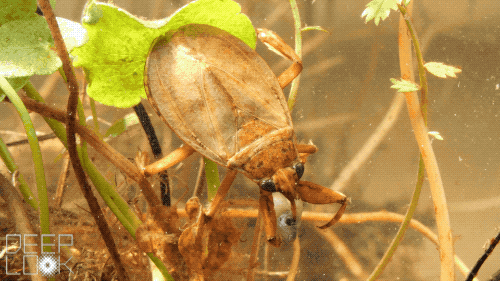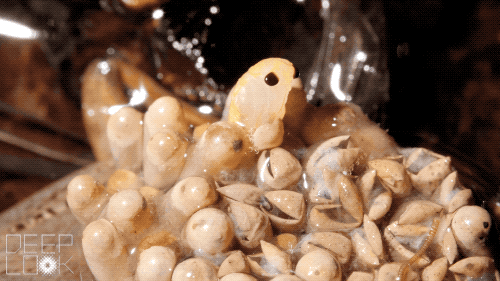This summer, as you cool your bare feet in a stream somewhere in California — or almost anywhere in the world, really — you might feel a painful nip. The menacing culprit: a giant water bug.
Lurking just below the surface of that flowing creek or refreshing pond, these bugs resemble enormous aquatic ticks, with googly eyes and praying mantis arms. And although they won’t seek you out for an attack, they also won’t hesitate to take a defensive bite if you get too close, earning them the nickname “toe-biters.”

They puncture the skin with dagger-like mouth parts, and have a bite known as one of the most painful of any insect — sharp and stinging like a wasp’s. You may not even get a chance to spot the offending insect before it dashes off, but you’ll undoubtedly be left with an indelible impression. And a swollen, throbbing toe.
Or, if you go chasing water bugs, like I did while researching this story, it could be your thumb that takes the hit. Ankle-deep in a cold stream near San Jose, I grabbed a submerged rock, flipped it over, and instantly felt a piercing jab. Sharp pain radiated out from the puncture site, marked with a red dot. I watched as my thumb swelled, gradually turning shades of blue and purple. The perpetrator and I locked eyes for only a second before it darted off like an aquatic bandit.

Giant water bugs are recognized around the world. In Brazil, they’re known as “escorpião d’água” (water scorpions). They prowl rice fields and other wetlands throughout Asia, where they’re considered a delicacy: One Thai dish serves water bugs with wings removed and bodies pulverized.
“You get this kind of a green lumpy substance that looks like guacamole, but doesn’t taste like guacamole,” says Robert Sites, an entomologist at the University of Missouri.
Sites describes the dish as quite tasty, with a nutty flavor. And it sometimes includes a useful prop.
“If you get one of the legs, you can use that as a toothpick,” he says.
Several species live in California’s ponds and streams, and most measure about the length of your thumb. When park rangers in the Santa Monica Mountains found healthy populations of giant water bugs near popular swimming holes in 2018, they warned the public to beware of their particularly unpleasant bites.
But our toes aren’t what water bugs are after. Giant water bugs prey on other aquatic insects, as well as animals as large as turtles, snakes and even ducklings — one naturalist in the 1800s even recorded one ambushing and devouring a woodpecker. Using their powerful, vice-grip legs, they subdue their victim before stabbing into it and injecting venom that liquefies the insides of their prey.
“They wait for everything to dissolve, and suck it back out,” says Chris Goforth, an entomologist and manager of citizen science at the North Carolina Museum of Natural Sciences. “Almost certainly, it’s still alive when it’s being eaten.”

Despite their aggressive and predatory nature, giant water bugs might just be the most responsible fathers in the insect world. In some California species, dad will haul his eggs around piggyback style for weeks, until they hatch right off his back.
“Parental care is unusual in itself,” says Sites, “but then actually attaching the eggs to the males — that’s another layer of complication.”

After mating, a female climbs onto the male’s back to lay row after row of eggs, gluing each one with a gooey substance oozing from her reproductive glands. Mom’s work ends here, and she swims off to prowl the shadows for her next meal.
But for dads, their job has only started. Most insects leave their eggs defenseless, relying on sheer numbers to get some of them through to hatching. By carrying the eggs on their backs, giant water bug dads can dodge predators and keep an eye on their babies. They’ll carry these eggs for weeks, shuttling them to the surface for air like an insect minivan.
“They’ll just bob up and down, ever so slightly,” says Hope Klug, an ecologist at the University of Tennessee at Chattanooga. “With the movement, they’re making sure that each individual egg is getting some oxygen to help it develop.”
After several weeks, the eggs have doubled in size and turned a milky white color. Suddenly, a pair of eyes is visible through each egg casing: The nymphs inside are getting ready to hatch. Within a few days, a transparent nymph pushes through, face first, unfolding its long limbs as it emerges.

Once it’s fully hatched, the nymph quickly swims away. If dad catches it, his instincts will kick in. Despite the weeks of careful parenting that he dedicated to ensuring the eggs’ survival, his offspring are now fair game as a tasty snack.
Sabrina Mendoza-Espinoza, who cares for more than a dozen water bugs on display at the San Francisco Zoo, put it this way: “They’ll go after anything that moves.”
Including their own children.
